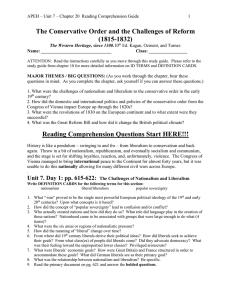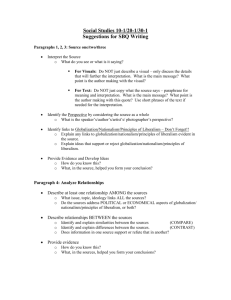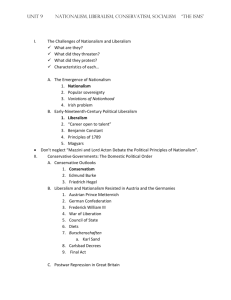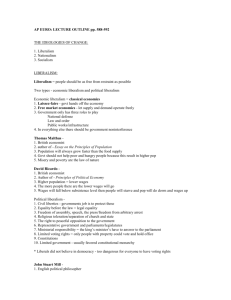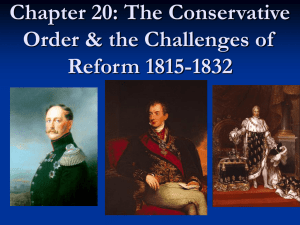The Conservative Order and the Challenges of Reform (1815 – 1832)
advertisement
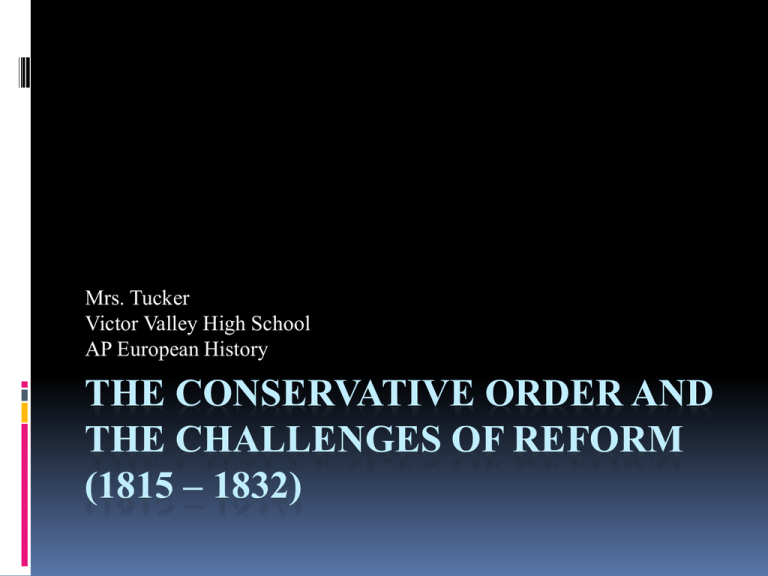
Mrs. Tucker Victor Valley High School AP European History THE CONSERVATIVE ORDER AND THE CHALLENGES OF REFORM (1815 – 1832) Main Objectives The challenge of nationalism and liberalism to the conservative order. Domestic and international policies of the conservative governments comprising the Concert of Europe. The Latin American independence movements. The revolutions of 1830 in Europe. The passage of the Great Reform Bill of 1832 in Britain. Challenges of Nationalism and Liberalism Secular ideologies including: nationalism, liberalism, republicanism, Socialism communism The Challenges of Nationalism and Liberalism In 19th century Europe all these "isms” were adapted by particular people, with particular needs and desires. in particular times and places; the words are useful only if they do not conceal the great variations among those who might be labeled as believers. The Challenges of Nationalism and Liberalism • Nationalism is the idea that people who share a common language, customs, culture, and history should also share the same government; political and ethnic boundaries should coincide. The Challenges of Nationalism and Liberalism Nationalists opposed multinational states that were held together only by the legitimacy of their rulers, as in the Austrian and Russian empires. The Challenges of Nationalism and Liberalism The widespread existence of minority enclaves – and even of members of the ethnic majority group who happen not to share nationalist aspirations – presented a practical problem for 19th century nationalists. (They continue to present problems for nationalists today.) The Challenges of Nationalism and Liberalism Nations were often created in the 19th century through the work of intellectual elites who used the print culture and schools to standardize a language and narrate a shared history. The Challenges of Nationalism and Liberalism Nationalism was particularly fervent, and often politically disruptive, in 19th century Ireland, Germany, Italy, Poland, eastern Europe, and the Balkans. The Challenges of Nationalism and Liberalism Liberalism in the 19th century sought a political framework that institutionalized the "principles of 1789," meaning that government was based on the consent of the governed as formalized in a written constitution. The Challenges of Nationalism and Liberalism Liberals were generally well educated and relatively wealthy; they did not trust the working class, and did not want full democracy. They believed that free trade would facilitate material progress. The Challenges of Nationalism and Liberalism As a practical matter, nationalism and liberalism were often linked in 19th century Europe, though in some situations the goals of nationalists and liberals were directly contradictory. Conservative Governments: The Domestic Political Order Conservatism, organized around the principles of legitimate monarchies, landed aristocracies, and established churches, established itself as a coherent political program in Europe in response to nationalism and liberalism. Conservative Governments: The Domestic Political Order Burke and Hegel were the most important conservative theorists, but conservatism was very much a product of local conditions. Conservative Governments: The Domestic Political Order Throughout Europe, the peace after 1815 presented problems; each country dealt with those problems differently. In Austria, prince Metternich was the closest thing to the Continent's mastermind of conservatism. As a multi-national state, Austria found nationalism and liberalism particularly threatening. Conservative Governments: The Domestic Political Order Metternich dominated the German Confederation, in which he limited the spread of constitutionalism. Conservative Governments: The Domestic Political Order Student movements were suppressed. In Great Britain, popular unrest was also suppressed, lest it lead to Parliamentary reform. liberal politicians. Conservative Governments: The Domestic Political Order The Bourbon king Louis XVIII ascended the French throne. He was keenly aware of the balancing act that his position required, as reflected in the Charter. Louis XVIII's moderation came to an end in 1820, however, when an heir to the throne was assassinated, and ultraroyalists persuaded the king to break with liberal politicians. The Conservative International Order The Concert of Europe was a device created at the Congress of Vienna whereby the major powers would meet from time to time to attempt to maintain international peace. It was unprecedented, and it was surprisingly successful, especially at first. The Conservative International Order The Spanish revolution of 1820 was consequential for Latin America, and, coupled with revolts in Italy, led Metternich to lobby the other powers for more active intervention in troubled regions. The Conservative International Order Greece and Serbia successfully revolted against the Ottoman Empire in the first third of the 19th century. Independence movements throughout Latin America took various forms, but had generally similar results, with a few exceptions. The Conservative International Order Between 1804 and 1824, Haiti won independence from France, Portugal lost control of Brazil, and Spain lost all of its American empire except for Cuba and Puerto Rico. The Conservative International Order Creoles in the American colonies generally retained their social and economic privileges. The wars of independence depleted the colonial economies, and the states created in the former Spanish Empire were weak. Overseas trade diminished. Britain took advantage of the opportunities this presented. The Conservative Order Shaken in Europe Starting in the mid-1920s, political discontent led to suppression in Russia, revolution in France, independence in Belgium, and accommodation in Britain. The Conservative Order Shaken in Europe The death of Tsar Alexander I in 1825 sparked a succession crisis, which led in turn to the Decembrist revolt of reform-minded army officers. The Conservative Order Shaken in Europe The revolt was harshly suppressed; the Decembrists came to be seen by later reformers as political martyrs. Nicholas I, who became tsar in 1825, feared reform at home and revolt abroad, so he ruled autocratically. The Conservative Order Shaken in Europe In France, the Bourbon dynasty was overthrown in July, 1830, after Charles X had attempted to concentrate political power in the monarchy. Louis Philippe's "July Monarchy" was politically liberal and socially conservative. The Conservative Order Shaken in Europe Belgium revolted against the Dutch in 1830, and became a constitutional monarchy. The Conservative Order Shaken in Europe In Britain, the Great Reform Bill, which became law in 1832, widened the widened the franchise and gave a broader section of Britain's population a stake in the existing political system.
